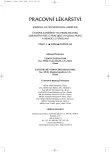Professional Rhinitis from the Perspective of the Occupational Physician
Authors:
S. Perečinský; Ľ. Legáth; M. Varga
Authors‘ workplace:
Klinika pracovného lekárstva a klinickej toxikológie LF UPJŠ a FN LP, Košice
prednosta: Doc. MUDr. Ľubomír Legáth, PhD.
Published in:
Pracov. Lék., 60, 2008, No. 3, s. 111-116.
Category:
Review article
Overview
Professional rhinitis is defined as an episodic sneezing related to work, nasal discharge and nasal obturation. Allergic and chronic nonallergic rhinitis are considered diseases of civilization. Their occurrence has increased ten times during the 20th century. Professional rhinitis accounts for 4% of respiratory diseases, whereas working environment contributes increasingly to the development of the disease (Departments of Labour and Public Health). Workers are exposed to an increasing number of different toxic, carcinogenic and antigenic properties. In the contrast to what was said above, the disease is underdiagnosed which is caused by inadequate diagnostics (there are no standardized diagnostic procedures) and unwillingness of patients to collaborate due to worries about the loss of employment. In their paper, the authors describe the epidemiological situation, etiological agents and diagnostic options in case of professional rhinitis (significance of undertaking nasal tests). At the same time, they stress the necessity of an early detection of the disease. Even though professional rhinitis does not endanger the life directly and does not require an urgent hospitalization and intervention, it decreases significantly the quality of life of the patient (in case of perennial rhinitis even more than in case of mild or moderate asthma). It contributes to the increase of work accidents, number of missed working days with the impact on the health care system economy and the whole society.
Key words:
allergic and chronic nonallergic rhinitis, epidemiological situation, etiological agents, necessity of an early detection, nasal test
Sources
1. ARANDELOVIĆ, M., STANKOVIĆ, I. Allergic rhinitis-possible occupational disease-criteria suggestion. Acta Fac. Med. NAISS., 2004, 21, 2, s. 65–71.
2. BOUSQUET, J. Allergic Rhinitis and its Impact on Asthma (ARIA) 2008 Update. Allergy, 2008, 63, Suppl. 86, s. 7–160.
3. BUC, M. Klinická imunológia. Prvé vydanie. Bratislava : VEDA, vydavateľstvo Slovenskej akadémie vied, 1997. s. 81. ISBN 80-220-0487-X.
4. D’ALONZO, G. E. Scope and impact of allergic rhinitis. J. Am. Osteopath. Assoc., 2002, 102, Suppl. 2, s. 2–6.
5. De BERNARDO, R. Occupational rhinitis. Occupational Airways, 2001, 7, 1, s. 1–4.
6. DIAZ-SANCHEZ, D., RUMOLD, R. A GONG, H. Challenge with environmental tobacco smoke exacerbates allergic airway disease in human beings. J. Allergy Clin. Immunol., 2006, 118, s. 441–446.
7. DRAKE-LEE, A., RUCKLEY, R. A PARKER, A. Occupational rhinitis: a poorly diagnosed condition. J. Laryngology and Otology, 2002, 116, s. 580–585.
8. DYKEWICZ, M. S., FINEMAN, S. Diagnosis and management of rhinitis: Complete guidelines of the joint task force on practice parameters in allergy, astma and immunology. Ann. Allergy, Asthma and Immunol., 1998, 81, s. 478–518.
9. EBO, D. IgE – mediated allergy from natural rubber latex. Brusel : FAB, 2000, s. 27, 62.
10. GENDO, K., LARSON, E. B. Evidence-based diagnostic strategies for evaluting suspected allergic rhinitis. Ann. Intern. Med., 2004, 140, s. 278–289.
11. GOSEPATH, J., AMEDEE, R. G., MANN, W. J. Nasal provocation testing as an international standard for evaluation of allergic and nonallergic rhinitis. Laryngoscope, 2005, 115, s. 512–516.
12. HANZÁLKOVÁ, Y., KRČMOVÁ, I. Návrh doporučeného postupu při provádění nazálního povokačního testu. Alergie, 2003, 4, s. 323–330.
13. HELLGREN, J. et al. Nasal symptoms among workers exposed to soft paper dust. Int. Arch. Occup. Environ. Health, 2001, 74, s. 129–132.
14. HRUBIŠKO, M. et al. Alergológia. 1. slovenské vyd., Martin : Vydavateľstvo Osveta, 2003. 519 s. ISBN 80-8063-110-7.
15. HYTONEN, M. et al. The risk of occupational rhinitis. Int. Arch. Occup. Environ. Health, 1997, 69, s. 487–490.
16. KUJALA, V. et al. Latex-induced allergic rhitis in a laboratory nurse. The Journal of Laryngology and Otology, 1995, 109, s. 1094–1096.
17. LEE, Y.-L. et al. Climate, traffic-related air pollutants and allergic rhinitis prevalence in middle-school children in Taiwan. Eur. Respir. J., 2003, 21, s. 964–970.
18. MARQUťS, L. L. et al. Occupational rhinitis due to pepsin. J. Investig. Allergol. Clin. Immunol., 2006, 16, s. 136–137.
19. MOSCATO, G. et al. Occupational asthma and occupational rhinitis in hairdressers. Chest, 2005, 128, s. 3590–3598.
20. NATHAN, R. A. et al. Objective monitoring of nasal patency and nasal physiology in rhinitis. J. Allergy Clin. Immunol., 2005, 115, s. S442–S459.
21. SHUSTERMAN, D. Toxicology of nasal irritants. Current Allergy and Asthma Reports, 2003, 3, s. 258–265.
22. SKONER, D. P. Allergic rhinitis: Definition, epidemiology, pathophysiology, detection, and diagnosis. J. Allergy Clin. Immunol., 2001, 108, s. S2–S8.
23. SLAVIN, R. G. Occupational rhinitis. Ann. Allergy Asthma Immunol., 2003, 90, Suppl., s. 2–6.
24. STORAAS, T. et al. Occupational rhinitis: diagnostic criteria, relation to lower airway symptoms and IgE sensitization in bakery workers. Acta Oto-Laryngologica, 2005, 125, s. 1211–1217.
25. VAN MOERBEKE, D. Allergic diseases as a public health problem. European Allergy White Paper, Brusel, 1997, s. 102.
Labels
Hygiene and epidemiology Hyperbaric medicine Occupational medicineArticle was published in
Occupational Medicine

2008 Issue 3
Most read in this issue
- Mental Work Load and Legislation
- Professional Rhinitis from the Perspective of the Occupational Physician
- A Review of Professional Diseases from Vibrations Reported in the Hradec Králové Region in 1997–2006 and the Role of the Occupational Health Care
- From the History of the Organizational Protection of Coal-miners of the Ostrava-Karvina Region (OKR) against Consequences Related to the Risk of Fibrogenic Dust
